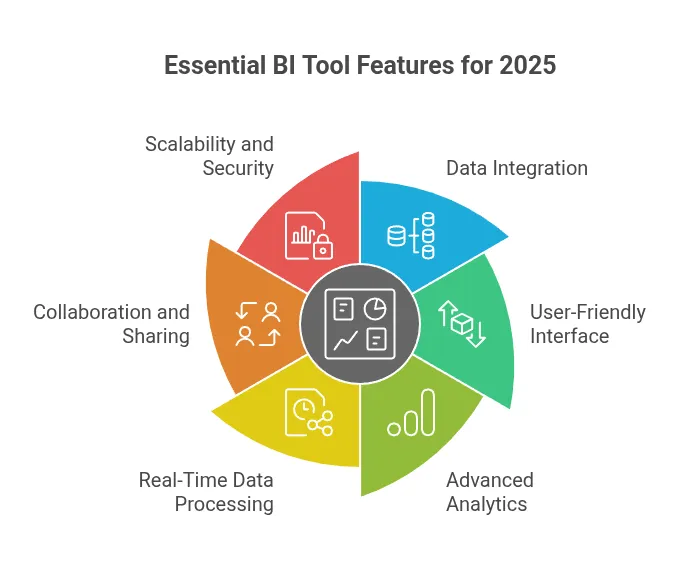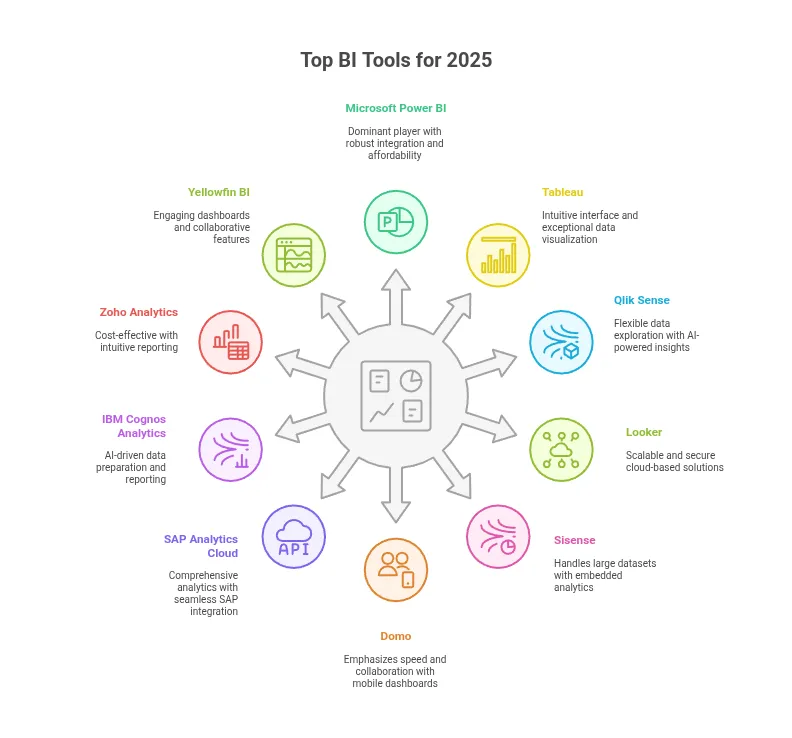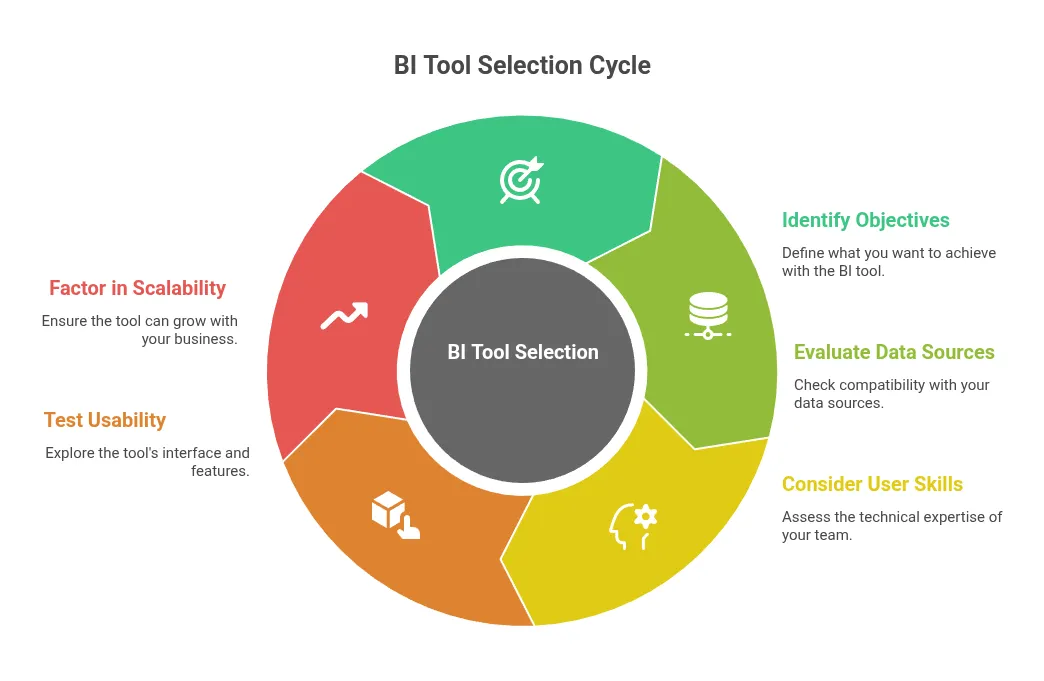Table of Contents
In today’s data-driven world, businesses are increasingly relying on best Business Intelligence software to transform raw data into actionable insights. As 2025 approaches, the landscape of BI platforms continues to evolve rapidly, offering more sophisticated features, better integration capabilities, and enhanced user experiences. Whether you’re a small startup or a large enterprise, choosing the right BI tool can make a significant difference in your decision-making process and overall business performance.
This article delves into the top business intelligence tools for 2025, ranking the top 10 platforms that stand out in terms of innovation, usability, and value. However, before we get to the list, it’s essential to understand what BI tools are and which features you should prioritize when selecting one.
What Are Business Intelligence (BI) Tools?
Business Intelligence tools are software applications designed to collect, process, analyze, and visualize data to help organizations make informed decisions. These tools gather data from various sources, such as databases, cloud services, and spreadsheets, and convert it into meaningful reports, dashboards, and visualizations.
At their core, BI tools help businesses identify trends, monitor performance metrics, and uncover hidden insights that might otherwise go unnoticed. This enables companies to optimize operations, improve customer experiences, and gain a competitive edge in their industry.
Unlike traditional reporting tools, modern BI platforms often incorporate advanced analytics, machine learning, and real-time data processing, making them indispensable for businesses aiming to stay agile and proactive.
One of the key features of BI tools is their ability to provide self-service analytics, empowering users across various departments to access and interpret data without needing extensive technical expertise. This democratization of data fosters a culture of data-driven decision-making within organizations, allowing teams to respond quickly to market changes and customer needs. Additionally, many BI tools come equipped with intuitive interfaces and drag-and-drop functionalities, making it easier for users to create custom reports and dashboards tailored to their specific requirements.
Furthermore, the integration capabilities of BI tools are continually evolving, allowing organizations to connect disparate data sources seamlessly. This means that businesses can pull in data from their customer relationship management (CRM) systems, enterprise resource planning (ERP) software, and even social media platforms to gain a holistic view of their operations. As a result, organizations can perform more comprehensive analyses, leading to richer insights that inform strategic initiatives and drive growth.
Key Features to Look for in a BI Tool in 2025

As BI technology advances, the features that define a top-tier platform continue to evolve. When evaluating BI tools for 2025, there are several key aspects to consider:
- Data Integration: The ability to seamlessly connect with a wide range of data sources—cloud databases, CRM systems, ERP platforms, and more—is crucial. The more versatile the integration options, the easier it is to consolidate data for analysis.
- User-Friendly Interface: BI tools should cater to users with varying technical expertise. Intuitive drag-and-drop features, customizable dashboards, and natural language query capabilities make data exploration accessible to everyone.
- Advanced Analytics: Look for tools that offer predictive analytics, AI-powered insights, and machine learning models. Businesses use these features to predict trends and help them make informed decisions.
- Real-Time Data Processing: In fast-paced industries, having access to up-to-the-minute data is essential. Real-time analytics enable quicker responses to market changes and operational challenges.
- Collaboration and Sharing: Business Intelligence platforms should facilitate easy sharing of reports and dashboards across teams, with options for commenting and version control to enhance collaborative decision-making.
- Scalability and Security: As your business grows, your BI tool should scale accordingly without compromising data security and compliance with regulations.
Keeping these features in mind will help you select a BI tool that aligns with your business needs and future growth plans.
Top 10 Business Intelligence Tools for 2025

After thorough research and analysis of market trends, user feedback, and feature sets, here are the top 10 business intelligence tools poised to lead in 2025:
1. Microsoft Power BI
Microsoft Power BI remains a dominant player in the BI space due to its robust integration with Microsoft 365 and Azure services. It offers powerful data visualization, AI-driven insights, and a highly customizable interface. Its affordability and ease of use make it a favorite among businesses of all sizes.
2. Tableau
Tableau is renowned for its intuitive drag-and-drop interface and exceptional data visualization capabilities. It supports a wide range of data connectors and excels in creating interactive dashboards that facilitate deep data exploration. Tableau’s strong community and extensive training resources add to its appeal.
3. Qlik Sense
Qlik Sense stands out with its associative data engine, which allows users to explore data freely without predefined queries. This flexibility, combined with AI-powered insights and self-service analytics, makes it a powerful tool for uncovering hidden patterns and relationships.
4. Looker (Google Cloud)
Looker utilizes Google Cloud’s infrastructure to provide scalable and secure BI solutions. It offers a modern modeling language called LookML. This allows teams to create reusable data models. Looker’s integration with BigQuery and other Google services makes it ideal for cloud-first organizations.
5. Sisense
Sisense is known for its ability to handle large and complex datasets with ease. Its end-to-end platform combines data preparation, analytics, and visualization, all in one place. Sisense also offers embedded analytics, allowing businesses to integrate BI capabilities directly into their applications.w
6. Domo
Domo provides a cloud-based BI platform that emphasizes speed and collaboration. It includes many connectors, live data updates, and mobile dashboards. Domo’s social collaboration tools help teams stay aligned and make faster decisions.
7. SAP Analytics Cloud
SAP Analytics Cloud builds comprehensive analytics capabilities. It proposes preparing, predictive analytics and business intelligence. It’s a strong choice for enterprises already invested in SAP solutions, providing seamless integration and enterprise-grade security.
8. IBM Cognos Analytics
IBM Cognos Analytics combines AI-driven data preparation with powerful reporting and dashboarding features. It supports natural language queries and automated data exploration, making it accessible to non-technical users while catering to advanced analytics needs.
9. Zoho Analytics
Zoho Analytics is a cost-effective BI tool that offers a wide range of integrations, intuitive drag-and-drop reporting, and AI-powered insights. This tool is popular among small to medium-sized businesses, as this is a powerful and easy-to-use solution.
10. Yellowfin BI
Yellowfin BI helps you tell stories with data, as it allows you to create engaging dashboards and reports. Its collaborative features and automated alerts help teams stay informed and act on insights promptly.
How to Choose the Right BI Tool for Your Business

Choosing the fitting and best Business Intelligence software needs careful review of your business needs, budget, and the technical skills needed for the tool. Below are some pointers to help you choose the right tool:
- Identify Your Objectives: Determine what you want to achieve with your BI tool. Are you looking to improve sales forecasting, monitor operational efficiency, or enhance customer analytics? If you know your goals, it will help you narrow down your choices.
- Evaluate Data Sources: Consider where your data resides and how easily a BI tool can connect to these sources. Compatibility is key to ensuring smooth data integration and accurate reporting.
- Consider User Skill Levels: Assess the technical expertise of your team. Some BI platforms are designed for data scientists and analysts, while others cater to business users with minimal technical background.
- Test Usability and Features: Take advantage of free trials and demos to explore the user interface, customization options, and analytical capabilities. Hands-on experience can reveal how well a tool fits your workflow.
- Factor in Scalability and Support: Choose a platform that can grow with your business and offers reliable customer support, training resources, and a strong user community.
By following these guidelines, you can select a BI tool that not only meets your current requirements but also supports your long-term business strategy.
Emerging BI Trends in 2025
The BI landscape is continuously evolving, and 2025 promises several exciting trends that will shape how organizations leverage data:
- Augmented Analytics: The integration of AI and machine learning into BI tools is making data analysis more automated and insightful. Augmented analytics helps users discover patterns and generate recommendations without deep technical expertise.
- Natural Language Processing (NLP): BI platforms are increasingly incorporating NLP capabilities, allowing users to interact with data using everyday language. This makes data access usable for everyone and helps with faster decision-making.
- Embedded Analytics: More businesses are embedding BI features directly into their operational applications, providing real-time insights within the context of daily workflows.
- Data Governance and Privacy: With growing concerns over data security and compliance, BI tools are enhancing their governance frameworks to ensure data integrity and privacy adherence.
- Collaborative BI: Collaboration features are becoming standard, enabling teams to share insights, annotate reports, and work together seamlessly on data-driven projects.
Staying aware of these trends can help businesses adopt BI solutions that are future-ready and aligned with evolving market demands.
FAQ
Q1. What is a business intelligence platform?
A business intelligence platform is a software system that enables organizations to collect, process, analyze, and visualize data from various sources. It helps transform raw data into actionable insights, facilitating better decision-making across departments.
Q2. What is the role of business intelligence?
The primary role of business intelligence is to support data-driven decision-making by providing accurate, timely, and relevant information. BI helps identify trends, monitor performance, optimize operations, and uncover new business opportunities.
Q3. What is the most popular business intelligence tool?
Microsoft Power BI is one of the most popular BI tools worldwide. Its affordability, ease of use, and integration with Microsoft make it a strong choice. However, popularity can vary based on industry, company size, and specific use cases.
Q4. What are the four types of business intelligence?
The four common types of business intelligence include:
1. Descriptive BI: Focuses on summarizing historical data to understand what has happened.
2. Diagnostic BI: Analyzes data to determine why something happened.
3. Predictive BI: Uses statistical models and machine learning to forecast future outcomes.
4. Prescriptive BI: Provides recommendations on actions to take based on data insights.
Q5. Is business intelligence an AI?
Business intelligence itself is not AI, but many modern BI tools incorporate artificial intelligence and machine learning technologies to enhance data analysis. AI-powered features can automate data preparation, generate insights, and enable natural language querying, making BI more accessible and powerful.